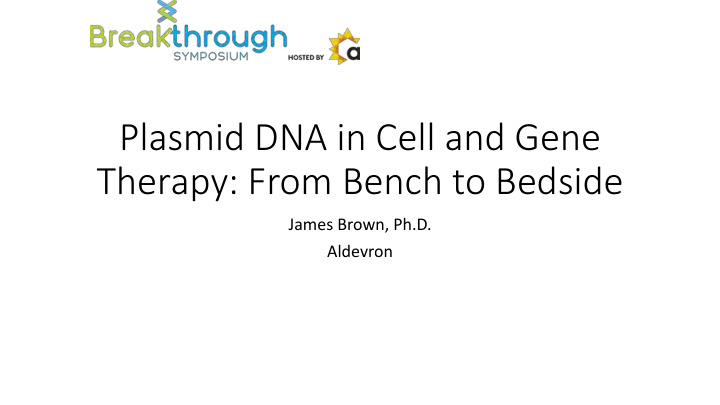



Plasmid DNA in Cell and Gene Therapy: From Bench to Bedside James Brown, Ph.D. Aldevron
Getting from here to there bench-to-bedside - A term used to describe the process by which the results of research done in the laboratory are directly used to develop new ways to treat patients.
What are the options? When do I use them? How do I move faster?
What’s the difference?
More alike than different…
What are the differences? Additional standard tests
What are the differences? Additional optional tests
What are the differences? QC service level
What are the differences? Production service level
Basic process is the same Transformation Growth Harvest Lysis Chromatography Diafiltration Quality Control
What are the differences? Scale and environment
What are the differences? In-process QC Transformation Growth Harvest Lysis Chromatography Diafiltration Quality Control
What are the differences? Facilities
What are the differences? Facility monitoring
…inside
…inside
Consideration on the path from bench to bedside Complexity of material Stage of Development Proximity to patient
Complexity of material Proteins Small Nucleic Antibodies Viral vector Live cells Enzymes Molecules Acids Increasing Complexity
Stages of Development http://www.ipmglobal.org/sites/default/files/Stages-Clinical-Trials2.png Consistent manufacturing process Consistent specifications Ability to scale up and out Increased quality oversight, process control, and environmental control for ancillary/raw material manufacturing
Proximity to patient Bacterial cell bank Plasmid DNA “Complexed” DNA
Proximity to patient Bacterial cell bank Plasmid DNA mRNA Bacterial cell bank IVT Enzymes
Proximity to patient Bacterial cell bank Plasmid DNA mRNA Transduced cell Bacterial cell bank IVT Enzymes
Proximity to patient Bacterial cell bank Plasmid DNA Viral vector Mammalian cell bank
Proximity to patient Bacterial cell bank Plasmid DNA Viral vector Transduced cell Mammalian cell bank
This is the direction Congress gave the FDA by creating vehicles like the accelerated approval pathway. How do we move even faster?
SC and OC isoforms were shown to be competent at directing target gene expression in vitro using both lipid mediated transfection and electroporation Taken together these results could be used to substantiate a reduced SC specification for a pDNA vaccine.
Should we cut corners? No! Risk assessment of options based on sound scientific principles and data.
Scale up, increase throughput
Scale out, personalized gene therapy Patient Patient Patient Patient Patient 1 2 3 4 n … Short TAT, on the order of weeks Development of parallel processing, closed systems http://clincancerres.aacrjournals.org/content/22/4/807
Immediate availability of critical components Cas9 pALD-X80 sv40 sv40 SpCas9 NLS NLS sv40 sv40 Nuc. SpCas9 His Myc HA NLS NLS NLS sv40 sv40 Spy Fi™ Cas9 NLS NLS sv40 sv40 AsCpf1 NLS NLS Off-the-shelf research and GMP/S products reduce timelines
Improve production processes Single-Use Equipment Reduce Product Carryover
The noblest art is that of making others hap happy. P. T. Barnum
Recommend
More recommend